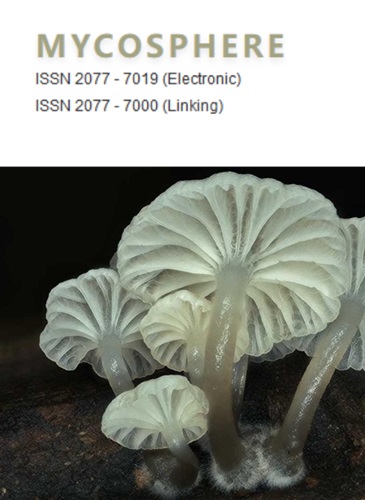担子菌科Polyporus及其相关属的分类、系统发育及分化时代
IF 15.1
1区 生物学
Q1 MYCOLOGY
引用次数: 18
摘要
水螅属是一个在分类学上有争议的属,它包括属于6个属群的种。近年来,根据系统发育和形态分析,许多种Polyporus被转移到其他相关属,即Cerioporus、Favolus、Lentinus、Neofavolus和Picipes。为确定该属及其亲缘属8个DNA片段,即与5.8S rDNA (its)的内转录间隔子1和2、核糖体大亚基(nLSU)、部分翻译延伸因子1-α基因(EF1-α)、线粒体小亚基(mtSSU)、β-微管蛋白基因(TUB)、RNA聚合酶II最大亚基(RPB1)、RNA聚合酶II第二大亚基(RPB2)和核糖体小亚基(nSSU)。用于分子系统研究。利用ITS+nLSU和ITS+nLSU+EF1α+mtSSU+RPB1+RPB2+nSSU+TUB两组数据进行系统发育分析,结果表明,水蛭属及其近缘属可分为6个支系,即支枝支系、细枝支系、新枝支系、香菇支系、核心支系和鳞片支系。此外,采用BEAST v1.8软件对6个DNA片段(5.8S、nLSU、EF1-α、RPB1、RPB2和nSSU)的保守区进行分析,分析了Polyporus及其相关属的分化时间和进化关系。贝叶斯进化分析表明,水螅门的祖先在141.81亿a左右分裂,而水螅门及其近属的6个主要分支的平均茎龄为49-63亿a。根据形态、系统发育和分化时间的综合分析,该支系的物种由质(鲜)到硬(干)担子胞和强分枝的骨结合菌丝组成了支管属;巢居于favolus枝和neofavolus枝的种被分别视为favolus和neofavolus两个不同的属;将香菇门分支中具有中心、浅色柱头和膨大菌丝的多孢子虫种转移到香菇门中,将核心的多孢子虫分支作为大孢子虫。鳞片门分支中包含了多个不同属的物种,即Datronia、Datroniella、Echinochaete、mycoonia、Neodatronia、polyporus s. lat。和Pseudofavolus,但没有足够有效的形态学证据将所有物种合并在鳞状真菌真菌圈13(1):1 - 52 (2022)www.mycosphere.org ISSN 2077 7019本文章由计算机程序翻译,如有差异,请以英文原文为准。
Taxonomy, phylogeny and divergence times of Polyporus (Basidiomycota) and related genera
Polyporus is a taxonomically controversial genus which includes species belonging to six infrageneric groups. Recently, many species of Polyporus have been transferred into other related genera viz. Cerioporus, Favolus, Lentinus, Neofavolus and Picipes based on the phylogenetic and morphological analyses. To ascertain the relationships of Polyporus and its allied genera, eight DNA fragments viz. the internal transcribed spacers 1 and 2 with the 5.8S rDNA (ITS), the nuclear ribosomal large subunit (nLSU), partial translation elongation factor 1-α gene (EF1-α), the mitochondrial small-subunit (mtSSU), the β-tubulin gene (TUB), the gene for RNA polymerase II largest subunit (RPB1), the gene for RNA polymerase II second largest subunit (RPB2) and the nuclear ribosomal small subunit (nSSU), are used in the molecular systematic studies. Phylogenetic analyses were carried out based on two combined datasets (ITS+nLSU) and (ITS+nLSU+EF1α+mtSSU+RPB1+RPB2+nSSU+TUB), and the results indicated that species of Polyporus and its related genera fell into six well supported clades: the picipes clade, the favolus calde, the neofavolus clade, the lentinus clade, the core polyporus clade and the squamosus clade. Moreover, the conserved regions of six DNA fragments (5.8S, nLSU, EF1-α, RPB1, RPB2 and nSSU) were used to analyze the divergence times and evolutionary relationships of Polyporus and its related genera by using BEAST v1.8. Bayesian evolutionary analysis revealed that the ancestor of Polyporales split at about 141.81 Mya, while the mean stem ages of the six major clades of Polyporus and its allied genera were 49–63 Mya. Based on the combined analyses of morphology, phylogenies and divergence times, species in the picipes clade formed the genus Picipes by the coriaceous (fresh) to hard (dry) basidiomata and strongly branched skeleto-binding hyphae; species nested in the favolus clade and the neofavolus clade were separately treated as two distinct genera Favolus and Neofavolus; the polyporoid species in the lentinus clade with central and light-colored stipe and inflated hyphae were transferred into Lentinus, and the core polyporus clade was treated as Polyporus s. str. The squamosus clade contained species belonging to several different genera viz. Datronia, Datroniella, Echinochaete, Mycobonia, Neodatronia, Polyporus s. lat. and Pseudofavolus, but there are no enough efficient morphological evidence to combine all species in the squamosus Mycosphere 13(1): 1–52 (2022) www.mycosphere.org ISSN 2077 7019
求助全文
通过发布文献求助,成功后即可免费获取论文全文。
去求助
来源期刊

Mycosphere
MYCOLOGY-
CiteScore
30.00
自引率
8.20%
发文量
9
审稿时长
4 weeks
期刊介绍:
Mycosphere stands as an international, peer-reviewed journal committed to the rapid dissemination of high-quality papers on fungal biology. Embracing an open-access approach, Mycosphere serves as a dedicated platform for the mycology community, ensuring swift publication of their valuable contributions. All submitted manuscripts undergo a thorough peer-review process before acceptance, with authors retaining copyright.
Key highlights of Mycosphere's publication include:
- Peer-reviewed manuscripts and monographs
- Open access, fostering accessibility and dissemination of knowledge
- Swift turnaround, facilitating timely sharing of research findings
- For information regarding open access charges, refer to the instructions for authors
- Special volumes, offering a platform for thematic collections and focused contributions.
Mycosphere is dedicated to promoting the accessibility and advancement of fungal biology through its inclusive and efficient publishing process.
 求助内容:
求助内容: 应助结果提醒方式:
应助结果提醒方式:


